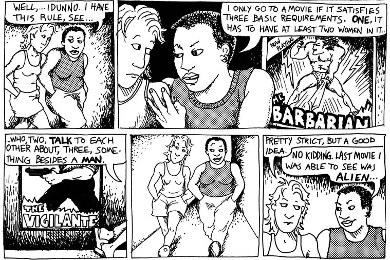On to talk about big characters.
I reiterate for the umpteenth time, I’m not doing this to judge other works. The scale I use for that is ‘did I like it?’ I think the BT has a lot of utility to improve my own writing though, so that’s what I’m writing about.
There are a few preliminaries to keep in mind. First, is the POV 1st person? If so, any demographic group other than the narrator will probably not pass the BT. If they do, this will require some odd gymnastics.
Take the Chronicles of Amber. The first five books were 1st Person POV by a male character, Corwin. It would be odd for him to overhear a conversation wherein he isn’t mentioned, and yet the conversation is significant enough to be included. Not impossible, but it would be odd. Furthermore, Corwin is a tremendous jackass and has a monomaniacal fixation on defeating first one then another of his brothers. He’s a bit obsessed. He’s also an immense jackass. He probably wouldn’t pay attention to anything that isn’t about him or one of his nemeses. Again, monumental jackass.
What I’m addressing is that the BT is a hammer. Don’t think all your stories are nails. POV, setting, and main character personality will influence whether this tool is useful. You can hammer in a screw, but I do not recommend it.
So I’ve got main characters Bob, Alice, and Ivan, the Face Stealing Serial Killer. Once Ivan gets introduced, he is going to dominate the plot. If Alice and her coworker Tasha are discussing the daffodils while Ivan stalks the office, they’re going to come across as loonies. On the other hand, they should have lives outside of Ivan.
So that’s fairly simple. Establishing their lives should be done before they interact with Ivan. This builds empathy with the reader, we have active motivations instead of negative, and we can do a little foreshadowing, drop a few plot hooks, etc. Later, we want to heighten the tension, but that isn’t exclusively about Ivan. It can be, but it isn’t always. If Ivan locks the doors and he’s inside with his meathook, characters can discuss how to unlock the doors, how to turn the power back on, how to put out the fires, etc.
Active motivations, ‘I want to live!’ are almost always better than negative motivations, ‘I don’t want to die!’ They’re more engaging, help me push the plot along, and when a reader wants to empathize with someone who wants to live, the reader wants to read and see if the character lives. If the reader wants to empathize with someone who doesn’t want to die, the reader can just stop reading and close the tab. Then the character doesn’t die for them. And I don’t want my readers to stop reading and close the tab.
So we have a clear timing issue. Alice and Tasha should have a conversation that isn’t about Ivan before Ivan interacts with them, or they should address some tension building facet after he’s introduced. Maybe Tasha got promoted from building maintenance, and she knows where the circuit breakers are. Maybe Alice has a gun in her desk. That’s a really good one, because most people don’t really know how to shoot guns, or even that there’s a skill involved, so the two of them could talk about how guns work. Sets up a nice contrast between ‘I’ve never even shot a gun because I feel bad for the paper targets!’ and Ivan, who murders people and steals their faces.
None the less, putting characters through the BT gives the author an opportunity to develop the situation.
Problem: Ivan’s disabled the power and the elevators don’t work. The building is also on fire. Ivan’s in the stairway.
Tasha: I can go to the power room and override the emergency brake on the elevators!
Of course something terrible will happen because everyone’s in a tiny metal box on janky power when the building is on fire, but hey, that’s drama!

